 authentication, to prove identity or gain access to a resource (example: an access code is
authentication, to prove identity or gain access to a resource (example: an access code is  a type of password)”.Wikipedia
a type of password)”.Wikipediawithout which there is no passage to what I need to be doing-such as weaving or writing or existing in more then a half life-anymore.
1. The act or process of passing, especially: A movement from one place to another, as by going by, through, over, or across; transit or migration.b.The process of elapsing: the passage of time.c. The process of passing from one condition or stage to another; transition: the passage from childhood to adulthood..d. The right, permission, or power to come and go freely:e. An occurrence or event: "Another encouraging passage took place . . . when heads of state . . . took note of the extraneous factors affecting their economies that are “beyond their control" .F. A segment of a written work or speech.Music A segment of a composition, especially one that demonstrates the virtuosity of the composer or performer: a passage of exquisite beauty, played to perfection.h. A section of a painting or other piece of artwork; a detail. None of which is going to happen until I remember which password is for which thing. |
YES! I have messed up my passwords-again- with a great deal of help from a dear person who will remain anonymous and the help of a Comcast techie. Fortunately, John the FFP techie saved the day and life is good for now! AND, AGAIN, I can never remember which I used for what. It’s amazing how many passwords we/I can accumulate in say a year. I can remember everyone of them with the exception of our Etsy account(a series of symbols), but not which ones I used for
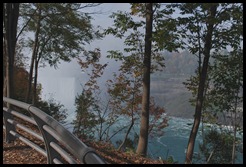 which. That, of course, doesn’t even count the 4 temporary ones given to me by Comcast to use until I could get ones that I can remember again. The one constant on my laptop until last night was the fingerprint swipe, which I have discovered doesn’t work after several days of intensively weaving tapestry. Passwords are an endless…pain!
which. That, of course, doesn’t even count the 4 temporary ones given to me by Comcast to use until I could get ones that I can remember again. The one constant on my laptop until last night was the fingerprint swipe, which I have discovered doesn’t work after several days of intensively weaving tapestry. Passwords are an endless…pain!Drop off at Niagara Falls!
Weaving progress so little to show
I have been so involved with trips, weaving with Shelley, yard work and pass word problems that I really haven’t woven much
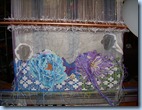 since the last time I wrote. Put as one can see. I did weave a tad more on the blue peony and have started the soumack outline of the black rose on the right side. It’s
since the last time I wrote. Put as one can see. I did weave a tad more on the blue peony and have started the soumack outline of the black rose on the right side. It’s 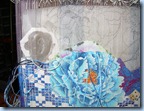 companion black rose which will be on the right side will be solid. I am weaving the two black roses from a photo of a very deep red rose bud that I received when my mother died this summer.
companion black rose which will be on the right side will be solid. I am weaving the two black roses from a photo of a very deep red rose bud that I received when my mother died this summer.Thank you to the person that returned my soumack sampler. It was greatly appreciated. No questions asked. I don’t means to sound greedy but could you also return the 4-5 others that were with it.
Thanks so much.
ENUFF SAID! ONWARD!

RYA---It’s been a million years since I have thought about weaving hairy stuff not fiber-pile. Well, at least since grad school in the barely 80’s. Now, I am researching rya weaving(?)/knotting. Up until a couple weeks ago when I started weaving with Shelley Rya was my cat. Mostly people think about rya as a Scandinavian, with a little(a lot) eastern influence thrown in for good measure. In the Seventies it seemed rya was a major influence on everything. It seemed to show up in every major textile artist work. Mildred Constantine's and Jack Leonard Larsen’s book The Art Fabric: Mainstream had dozens of pictures of major weavers of the time using rya and tapestry and just about every other technique as a woven ground fabric. I never felt really excited enough to really attempt to use the technique in my personal designs. I do remember seeing several rugs very white rugs that Pat Spark wove when I was in graduate school that had Islands of long, short ropy and smooth rya. It was my first introduction to sculptural rya that wasn’t dark and dingy looking. I was too fascinated with flat woven tapestry to try anything else beside tapestry. The things that did interest me
 about rya was the wild and hairy historical samples of early Viking rya blankets and wall hangings, tufted Navajo saddle blankets, Apache blankets and a few samples of South American weaving. They all used tufts of fiber or in the case of Apache blankets stripped rabbit hide.I have seen at least one pictorial example that uses rya knots in an Apache for the tufting in either my Amsden, or James I am just to lazy to look it up right now.
about rya was the wild and hairy historical samples of early Viking rya blankets and wall hangings, tufted Navajo saddle blankets, Apache blankets and a few samples of South American weaving. They all used tufts of fiber or in the case of Apache blankets stripped rabbit hide.I have seen at least one pictorial example that uses rya knots in an Apache for the tufting in either my Amsden, or James I am just to lazy to look it up right now. Some of the things I am learning about rya in the last couple of weeks analyzing the process in my mind and weaving with Shelley is what it takes to control the pile. Shorter closer together knots make a more stand up stiffer pile. Long and luxurious pile is created by longer tufts of the rya and more counters or ground fabric between the rows of knots. The type of fiber used in the knotting and tufting can also completely change the texture of the pile and perhaps it’s symbolic meaning. Designs or patterns of the pile become very defused the longer the pile. The more the distinct the designs in the knots the shorter the pile needs to be and the closer the knots need to be together.
Another technique I have re-fallen in love with is zilli. I have worked with zilli a little bit
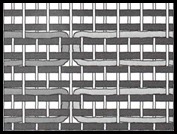 in several samplers, but never in a large tapestry. I had with it in samplers and discussed the results in my Lines and
in several samplers, but never in a large tapestry. I had with it in samplers and discussed the results in my Lines and 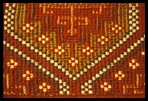 Tapestry book. Worked with it in samplers and discussed the technique in several lectures that I gave to docents for various exhibits. I have come to realize while working with Shelley on the new tapestry that the floats are nice, but there is a second element that I had never considered the counter or plain woven line that also creates a vertical
Tapestry book. Worked with it in samplers and discussed the technique in several lectures that I gave to docents for various exhibits. I have come to realize while working with Shelley on the new tapestry that the floats are nice, but there is a second element that I had never considered the counter or plain woven line that also creates a vertical . So, like with pick and pick you could create a second image within the vertical stripes running up the warp, while the floats create another image.
. So, like with pick and pick you could create a second image within the vertical stripes running up the warp, while the floats create another image. 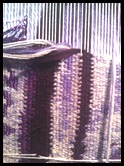
Crenulated weave structures are always fascinating. I tend to think of them as very very small hatches like over one warp thread. Of course there are many types of the structures. The Scandinavian weavers used them for deign and technique. The middle Eastern weavers used them as both design and ways to close large slits structurally. At times in English there is a bit of slang that calls them zippers. Shelly uses a lot of them in her weaving. She
 views them as sutures which gives them a heavily laddened sense of symbolic meeting for her. I had never really looked at the crenulated structures as anything but a technical element to close slits, make borders, and being related to hatches when stacked in a certain way. Totally unattached in my mind as part of meaning. This is a det
views them as sutures which gives them a heavily laddened sense of symbolic meeting for her. I had never really looked at the crenulated structures as anything but a technical element to close slits, make borders, and being related to hatches when stacked in a certain way. Totally unattached in my mind as part of meaning. This is a det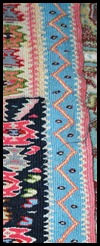 ail from the large tapestry that Shelley and I are weaving. In middle eastern weaving they are used in a less random fashion and usually in the borders and surrounds. This is a border detail of on one of my favourite Afghani rugs of a crenulated border.
ail from the large tapestry that Shelley and I are weaving. In middle eastern weaving they are used in a less random fashion and usually in the borders and surrounds. This is a border detail of on one of my favourite Afghani rugs of a crenulated border. I should mention that the diagrams are from my books and Pat Spark created them.
Other things-Somewhere a long the way when weaving on my own tapestries there is a point where there is suddenly a knuckle bump moment, high five, aha when one knows it’s all coming together and the idea has jelled enough in the weaving that a sense of joy or a knowing that it’s right happens. Seems to take a little longer when I am working on someone else's tapestries. I have finally reached that Point in “And He...” I am roughly a quarter done.
One of the questions I am frequently asked(other then how long does it take) is what is the difference between weaving ones own design and weaving someone else’s designs. When I am working on someone else's tapestries and the decisions aren’t mine to make it still takes time to find ones comfort level. Weaving someone else's design is a different thought process. As corny as it sounds, it’s almost a negation of self and it is definitely a test of self discipline-not a bad thing. It’s a different mind process when trying to make ones personal style conform to another's dreams and images. The easy part is the technical part of weaving. The not so easy is remembering it’s not yours to mess around with. BUT, it’s a fun and dynamic change to be weaving side by side with Shelley on one of her designs-again.

Sunday Chene, Spencer and I leave to teach in Albuquerque, NM. at Village Wools. WE are driving! I am so looking forward to the trip. I understand there are a few more spaces left in the class if anyone wants to join us. The class is a Beyond More. It’s about designing for tapestry and making the techniques of tapestry work right in your weaving. The class is a multilevel class.
cheers,
kathe